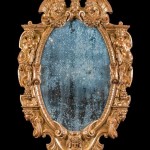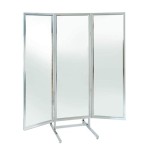What Type of Mirror Is Used in Car Headlights?
Car headlights, essential for safe nighttime driving, rely on precisely engineered reflectors to project a beam of light forward. Understanding the type of mirror used and its characteristics is crucial for comprehending how headlights function.
The mirror utilized in car headlights is a
parabolic reflector
. Unlike a spherical mirror, which suffers from spherical aberration (where light rays don't converge to a single point), a parabolic mirror possesses a precise geometric shape that focuses parallel rays of light onto a single focal point. This property is fundamental for creating a controlled and directed beam suitable for illuminating the road ahead.A parabola is a specific type of conic section, a curve formed by the intersection of a cone and a plane. The unique reflective properties of the parabolic shape stem from its mathematical definition. For any point on the parabola, the distance to a fixed point (the focus) is equal to the distance to a fixed line (the directrix). This ensures all incoming rays parallel to the parabola's axis of symmetry reflect and converge precisely at the focus.
In a car headlight, the light source, typically a halogen, LED, or xenon bulb, is placed at or near the focal point of the parabolic reflector. As light emanates from the bulb in multiple directions, the parabolic mirror reflects the rays traveling towards it. These reflected rays emerge parallel to the axis of the parabola, forming the concentrated headlight beam.
The precision of the parabolic shape is critical. Any deviations from the ideal parabolic curve will lead to scattered light and a less effective beam. Modern manufacturing techniques ensure the reflectors are highly accurate, maximizing light output and beam control.
While the core principle remains the same, the actual implementation of parabolic reflectors in car headlights can vary. Some headlights utilize a single parabolic reflector with intricate internal structures to shape the beam pattern. Others may employ multiple parabolic reflectors, each responsible for a specific part of the overall beam, like high beams and low beams.
The material used for the reflector is also significant. Typically, it is made of highly polished metal, often aluminum or a specialized plastic coated with a reflective layer. The material needs to be highly reflective and durable to withstand the harsh conditions within the headlight assembly, including heat and vibration.
The reflected light from the parabolic mirror passes through a clear lens covering the front of the headlight. This lens further shapes and directs the beam, contributing to the overall light distribution pattern. The lens can have specific patterns and textures to refract the light and achieve the desired illumination characteristics.
Regulations govern headlight beam patterns to ensure they illuminate the road effectively without blinding oncoming drivers. These regulations specify the intensity and distribution of light, requiring careful design and engineering of the entire headlight assembly, including the parabolic reflector and lens.
Advancements in headlight technology have led to more sophisticated beam control systems. Adaptive front lighting systems, for instance, can adjust the direction and intensity of the headlight beam based on steering input, speed, and road conditions. These systems often utilize complex reflector designs or projector-style headlights with movable internal components to dynamically shape the light output.
Understanding the role of the parabolic reflector is crucial for appreciating the functionality of car headlights. This precisely shaped mirror, combined with the light source and lens, forms a crucial safety feature, enabling drivers to see clearly at night and in adverse weather conditions. The ongoing development of headlight technology continues to refine this system, enhancing visibility and road safety.
The evolution from simple parabolic reflectors to complex adaptive systems highlights the continuous improvement in headlight design. This ongoing development is driven by the need for greater safety and improved visibility in various driving conditions.
The parabolic reflector, while a seemingly simple component, represents a sophisticated application of optical principles. Its precise shape and reflective properties are essential for creating a controlled and effective headlight beam, ultimately contributing significantly to driver safety.
Further research into parabolic reflectors and their applications can be found in various scientific and engineering resources. Exploring these resources provides a deeper understanding of the principles behind light reflection and the crucial role of parabolic shapes in focusing light.
Which Mirror Is Used In The Headlight Of A Car Quora

Car Headlights

Which Type Of Mirror Is Used In Headlights Vehicles

State The Type Of Mirrors Used For I Headlights And Ii Rearview In Cars Motorcycles Give Reason To Justify Your Answer Each Case

Which Mirror Is Used In The Headlights Of A Car
Flashlights And Car Headlights All Have Concave Mirrors Why Would It Not Be A Good Idea To Use Convex Mirror Instead Quora

Concave Vs Convex Mirrors In Cars

8 Name The Type Of Mirror Used In Following Situations A Headlights Car B Side Rear

Spherical Mirror Structure Types Terminologies

Concave Vs Convex Mirrors In Cars








